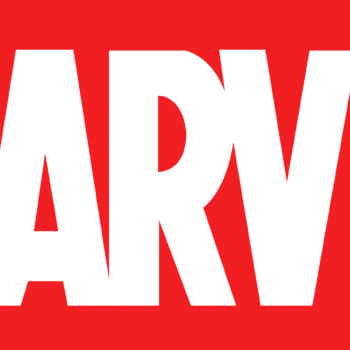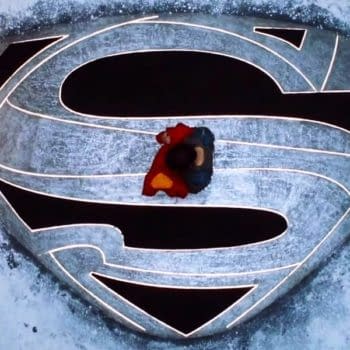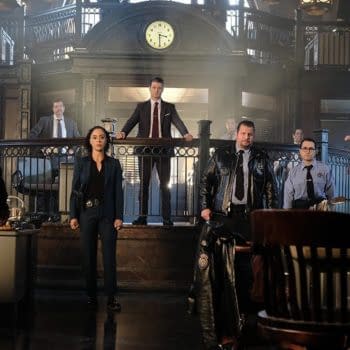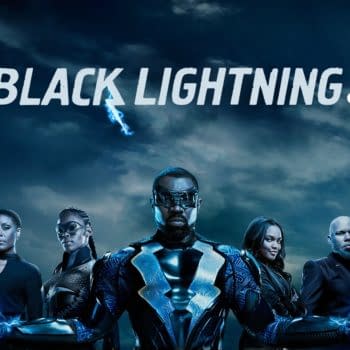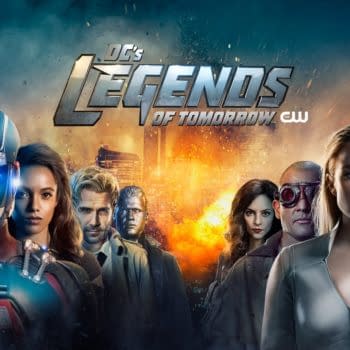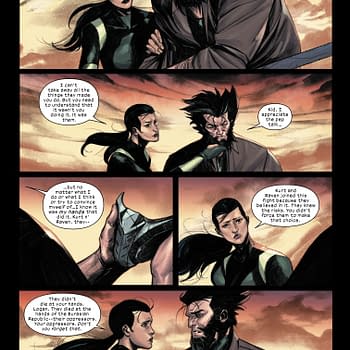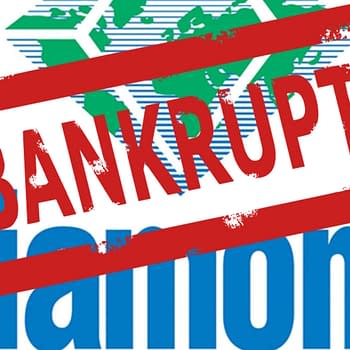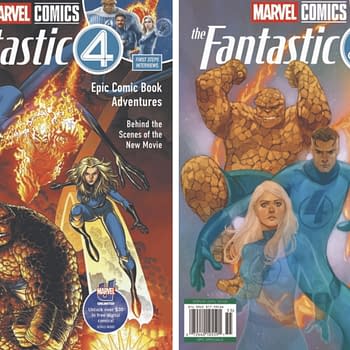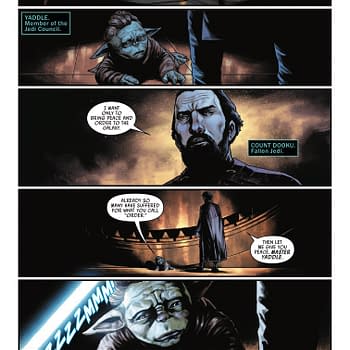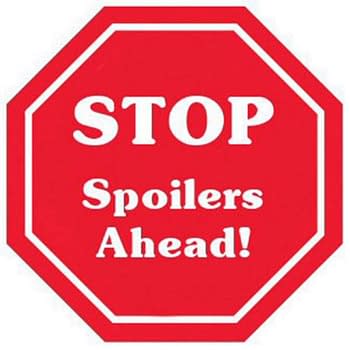Posted in: Comics | Tagged: Antonio Fuso, Comics, entertainment, james bond, jamie mckelvie, kieron gillen
Writer's Commentary – Kieron Gillen Talks James Bond Service
A Writer's Commentary: Kieron Gillen on James Bond Service Special, on sale from Dynamite. Cover by Jamie McKelvie and interiors by Antonio Fuso.
This was an interesting project. Nick and I have been talking about doing something together for the best part of a decade, and the stars have never aligned. When he suggested a Bond one-off, it struck me as a great way to actually finally dance AND write an icon. I thought it would be a giggle and fun.
In practise: this was oddly nightmarishly hard to do. Fun, but hard. Not in terms of execution, or working with Antonio, Chris or Simon (who were all a delight) but in terms of generating an idea I felt worth telling. I had two core things I knew — a beat where Bond lets an assassin take a shot to gain political leverage, and the general theme of British identity in the era of Brexit. The rest took work.
That said, it is so out of my traditional wheelhouse, it taught me a lot. Also, I was right — writing an icon was exactly how fun I thought it would be. The story was a problem, but Bond himself is as perfect a creation for his purpose as a Great White Shark is for its. From my first line, my Bond was there in exactly the same way my take on any other icon I've ever written has been. There's a reason why they work.
Jamie McKelvie's Cover
My long-term collaborator was kind enough to do a cover. Obviously picturing the setting of the comic (more of that on the inside) and very much Freudian masterpiece. Go Jamie.
Page 1:
The book is Book Bond, but there's always a hologram aspect with the Movie Bond. Where do you draw the line? The Book Bond is a harsher character than the movie Bond — often much harsher. I played with making the first line even more dismissive before backing off a little. It's probably not a good idea to despise your lead in the first panel, right?
Only appearance of the Bond Girl trope in the issue. Writing an icon was, at least in part, hitting some of the tropes, and finding an angle on them. Bond as Womanizer doesn't particularly interest me, at least in a short story like this.
I originally set this at the Groucho Club for full on moneyed salubrious , but decided specificity wasn't necessary. Antonio summons that mood of a London club here, dropping him into this world that is perpetually late and glamorous.
"Fiction" always being a loaded in one of my scripts. I'm a fan of the square-panels-as-TV-screens approach, even thought TVs aren't that shape any more.
Page 2:
The Imperial War Museum. South London, near Elephant and Castle. I walk past it on the time, on my way to by time wargame stuff from the Black Sphere gaming shop.
As part of my research and trying to jump-start my thoughts on Bond, I took a trip with a friend here, and looked around — specifically, there's a Spycraft exhibitions which I hoped would help. It did — the core idea of looking at the idea of Britain drawing a line between WWII (as in, its origins) and Now struck me as interesting. As in, that's the sort of stuff which immediately makes me want to dig into it.
Also, a number of useful visuals immediately presented themselves.
Page 3:
Anyway — Felix here, and his look positions it in the timeline of the Bond comics. See the Felix comic for more details, true believer, etc.
Explicit name-check for the exhibition I visited. I go to the War Museum…if not regularly, at least sporadically. I actually wrote the opening of my Avatar comic UBER in here, way back in 2008.
The "two spies wandering in a public place and having a conversation" is pure spy fiction for me. In terms of thinking of approach to the book, I was looking at what Warren and Andy were writing, but I was also thinking of what Greg Rucka wrote with the Oni classic Queen and Country (which was based on the hyper-realistic Sandbaggers TV show.)
As a basic obvious thing, having a picture of modern Britain in terms of the diversity of the crowd scenes and the rest of the cast was a "thing". It's something you should be doing as a writer or artist anyway (you can google demographics of any place on earth, basically, so there's no excuse to not have authenticity in an authentic-set comic) but in a comic with this theme, it's more essential.
Page 4:
I wrote this before the US election and there were small but significant tweaks to the script after the results came in. The "the Kremlin is getting more hard data" line actually was in the first draft, and obviously reads different now.
The "you guys should know that" should be a give away that the script was written after the Brexit vote in the UK. Odd time to be writing a book like this.
Anyway — that's the Imperial War Museum. Do go visit, it's an excellent place. I'm sure we won't be back here before the end of the comic, and definitely not in an action set-piece.
Page 5:
The "do a Moneypenny scene" is certainly on the trope list of things I'd like to write. If I had another four pages in the comic, I'd have had a mirrored scene where Moneypenny gets a call back revenge to this.
Antonio's choices here are interesting — he's a realist artist, trying to imply an adult world with clean, hard lines. However, in things like the fourth panel you see the other side to him — that silhouette full-length shot is much more abstract.
Page 6:
An M briefing is also on the trope list.
You may note my Bond leans a little more playful verbally. Good question as to "why?". I tend to think as Bond as literally untouchable. The jokes seem less to entertain and more to show how distant he is. I can joke about anything, as I've seen everything. It's the sort of black humour a paramedic may trade in.
British Tabloids are amazing. Do I regret not making the headline a pun? I'm not sure. It'd be accurate, but also got a laugh where I didn't necessarily want one.
Page 7:
Another silhouette shot here — as said, for all the realism, Antonio interjects these mood beats.
"Denbigh North" is probably the least glamorous sounding location Bond has ever been sent. I was nosing on the map around Bletchley, trying to find an area by Bletchley which wasn't just called "Bletchley." Obviously, saying that gives the game away.
A full Q-quartermaster scene with Bond would also be on the trope list, but we have the high tech in here. We get a Q beat later, which scratches THAT itch.
I mentioned the emotionally distant part of Bond, and the drones joke is probably the best example of it — lampshaded by M. When you write a joke that's a character point, it's occasionally worth doing so. I like M's cold dismissiveness of Bond here, which strikes as a very natural response to someone like Bond.
Page 8:
Bond comics have tended to work in a cinema-on-paper mode. As in, clear storytelling whose techniques are lifted from the screen. This isn't. This sequence is pure comics, but also show-not-tell. It's primarily born from wanting to show Bond actually do some legwork, but not having pages to burn showing it. A hyper-compressed visual-language sequence was my response.
The lady in the post office was inspired by the ladies who run my local post office.
Has Antonio used Angela Lansbury as his reference for the landlady in the last panels? I approve.
Page 9:
The plan was to show this in a step-by-step procedural approach, a la Rorschach in the first chapter of Watchmen — just thinking through a problem, about to try something, has better thoughts, look for another angle, and…
Page 10:
Yeah, it was trapped.
Chris' choices in colours when we're getting more actual action is interesting — the oranges juxtaposed with this old sense of '70s Britain in the scenery.
Slant on the first panel gives a sense of direction to the bomb. Also, the Silhouette in the last panel used for an alternative approach — not about mood, but for focusing in on a core visual aspect. As in "Here is a wire."
Page 11:
Juxtaposition between modern tech and WWII period tech is of course a "thing" in this story.
Bond looks a little like David Kohl in the final panel. Well, David Kohl in a wig. Phonogram crossover is go!
Page 12:
Antonio took this page interestingly — the view to get Bletchley Park is somewhat distant, so the intersection of a map is a very graphic, pure-comics approach to the problem.
I like the visual of Bond, casually in a burning room, looking out at the past. I'm not sure it was a visual metaphor, but it certainly works.
Enigma Code being WWII German code, broke at Bletchley Park.
Page 13:
Q's complaining about not getting a chance to play with Colossus echoes my own. Part of me would have loved to have took a few pages and done that, but I) I didn't have the space and ii) god knows they'd have just ran an emulator. Facts are boring.
Page 14:
A little bit of a history lesson, which is the core research which led to the story. The Auxiliary units were basically going to initially blow as much stuff up behind enemy lines to cause disruption in the initial stages of a German invasion. Tellingly, they were basically meant to do it, and then be rapidly killed.
I did do a draft which included various other bits of Spycraft history, but it really was too much. Especially the bit about how one of the very earliest invisible inks used was made of semen. If this was a Roger Moore-esque sex-comedy bond, you can imagine the scene though…
Bond: "Hmm. I need to leave a secret message."
Bond Girl: "Is there anything I can do to help?"
Bond: "Why, yes, if you could just lend a hand…"
I digress.
Page 15:
Okay, this "Let me thank you for the coffee" beat is a little bit Roger Moore.
Page 16:
More hard-tech spycraft stuff. I don't think technothriller is actually anywhere near my core interest of a writer, but I love seeing this kind of stuff.
Good choices of colour by Chris here too.
Page 17:
Random art/interplay choice here — I originally scripted all the dialogue of panel two and three in panel two (i.e. three was silent). After drawn, with Bond so casual in the second panel, that much dialogue implies too much time for the guard to turn around. As such, a lettering tweak to get more sense of speed.
Double hyphen to break a speech balloon to imply a sudden interruption is one of my favourite things.
Page 18:
And enter our main villain. Always interested in how the visual side of this work — it's halfway through the book and we're just seeing him. You have to sell him as a threat.
Nice big central impact panel.
Page 19:
Interesting purple-bruise colouring from Chris, as the beating continues.
Page 20:
WWII classic interrogation, seguing into The Bond Trope.
Page 21:
Getting Marshall's voice was a tricky one. I ended up with this oddly almost poetic diction, which separates him from everyone else.
Antonio's framing of the last panel is interesting — in terms of British icons, the lower-face shot always recalls Dredd.
Page 22:
The font choices for the whisper by Simon is a particularly good one.
Balancing the politics of the comic is pretty tricky. The juxtaposition between the various people is pretty key.
I'm calling out al these silhouette shots, but here's another one. When I see a theme, I like to follow it. A silent panel is, as a choice, often about timelessness. A panel can be a moment in time, or it can be an endless period. Here, with no motion, and this wide panel, it's always going to feel pregnant. Does the iconic, silhouette approach to the figure increase that? Perhaps.
Page 23:
The head scratch by the racist in the first panel is one hell of a pose.
I'm a big fan of steady-angle approach for more (blackly) comic beats. I suspect I picked it up from Garth Ennis.
Bond sure does get punched a lot in this comic.
Page 24:
Oh my! We're back at the Imperial War Museum. This is like a real big boy plot structure. Eisners for everyone!
You drown in the Sahara by finding an Oasis. Or bringing a bucket of water and having someone hold your head beneath the surface. It's difficult, but it just takes dedication and planning.
That's a Bren light machine gun, which is a classic of British War comics. I was one of the last generations of British kids to really have war comics as part of their cultural input while growing up. Battle was the classic, including work that still gets talked about now — anti-war WWI horror show for kids Charlie's War is the obvious touchstone, but there's much more here. There were some recent republications with introductions by Garth Ennis, if you're interested in exploring.
Page 25:
There's that double-hyphen to imply stuff happening again.
Like the lateral motion on panel three, and the cut to panel four, where we get the violence in silhouette. It's evocative, and obviously implies the violence, but without wallowing into it. This isn't really that kind of book.
Page 26:
Another normal colouring, limited colouring (though strictly speaking not pure silhouette) shot, which captures the moment of violence well.
Page 27:
I'm not a huge fan of using sound effects in realistic mode work, but occasionally they're the only option when you're having to compress. Given another page, I may have (say) panned away from the fight, showing where the breaching hole is, and then going to the sewer. At which point, you may go "why didn't you do that then?" It's that I decided other things were more important. That's about 9/10ths of comic writing, really — prioritising your narrative choices.
Brainstorming on what to use to cut the rope led to friend Ray Fawkes suggesting an ultra-sonic cutter, which struck me as a good idea. Thanks, Ray!
Page 28:
The point of the last four panels is to show that Bond knows that the pistol isn't aligned — he missed. Clearly, that's not normal. Making sure that it's clear that Bond knows it's not going to shoot straight is key — we spend half a page on it, plus adding dialogue to make it clear Bond is annoyed over something.
Page 29:
Strong choices for oranges and yellows by Chris in that central panel.
Reading this action sequence is making me want to re-read the Losers by Diggle and (primarily) Jock. Er… plugging other companies' books isn't really what these writer notes are about, are they?
Page 30:
Bone drops the gun, which is then retrieved by the villain. Chains of causality matter to me, shall we say.
The colours changing in the final panel with the blues on the terrorist is emotional foreshadowing, I think. For…
Page 31:
Yes, the silhouette-for-violence motif. Er…it sounds like I'm taking the piss, but I'm trying to highlight how Antonio is creating a rhythm in these sections.
Bond is picking up a Sten gun, which is the iconic British Sub-machine gun. In my list of Things I Wanted To Do was "Have Bond shoot someone with a Sten Gun."
The chase sequence takes us into the actual real SpyCraft exhibit, which should map exactly to the real one. The joys of using real locations, is that you get to use real maps.
Page 32:
The door may be the cheat here — I'm not 100% sure there's a door down that corridor, but it's a minor one.
That MI6 sign being on the wall is what we call in the business a lucky coincidence. Unless Antonio cheated to put it there, in which case more power to him.
The problem here as a storytelling element is articulating the 3D space to the reader — three men, two of which aiming at the other one, and the one who isn't can't see the first one. As in, the Secretary is not aware of Bond's presence here (or able to see what he does or doesn't do).
Page 33:
You may wonder when I talk about having to balance demands of space earlier, why I'd drop to three panels here. Space is meaning. This is the core decision of the whole story, and we want to really give the space.
(Plus "compress" isn't always an answer. When doing a lot of work, you want pages to work as narrative units, and that doesn't work)
Anyway — this gives lots of space for Antonio to work the expressions. That's a really naturalistic fear in the first panel — it's not an over-acted terror. The falling of the shadows also works really well.
Page 34:
Interesting choice in terms of breaking the panel borders to the level of completely losing the panels in this key moment — especially as that's not really a choice that he's made elsewhere in the book. There's some minor panel-breaking, but nowhere where we lose the panel itself.
Page 35:
And we move to the denouement at speed — I'm quite fond of the plaster-pulling-off approach.
Seriously, Antonio, strong placement of the MI6 symbol. The framing here in the final panel is excellent all around.
Another five-panel page, this time with a grid — which I don't think I called for, but is a very "me" move. Especially when working with an artist I've never worked with, I tend to keep to a five-panel beat for most of the scenes, which is a little higher than some modern writers, but normally a rock solid way of telling action stories. It's very much Garth Ennis' main mode as a writer
Page 36:
And scene, with another five-panel shot. I do like the establishing of the MI6 building, both this time and earlier. Of course, "external establishing shot with dialogue emerging from interiors" is a fairly classic comic choice, just for efficiencies' sake. The only problem with it is that you need to be sure that the reader knows who's speaking, or it can cause a little dissonance. We try to hold hand with the 007.
This bit of hard real-politik is very much the Sandbaggers influence in the strip.
The enigmatic choice of that final panel is an interesting one from Antonio. Mine was a little wider, but it also captures the unresolved nature of this.
Also, makes me need a drink.
Thanks for reading.









